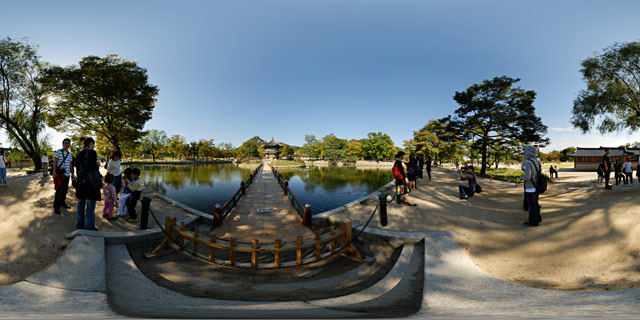
Hyangwonjeong Pavilion, Hyangwonji Lake, Chwihyanggyo Bridge 360 VR

Click button below to view 360° VR interactive panorama
SD Standard definition suitable for users with slow internet connections or mobile devices or HD High definition suitable for users with fast internet connections
360° VR panorama of Hyangwonjeong Pavilion, Hyangwonji Lake, and Chwihyanggyo Bridge in Gyeongbokgung Palace, Seoul, South Korea.
Gyeongbokgung, also known as Gyeongbokgung Palace or Gyeongbok Palace, is a royal palace located in northern Seoul, South Korea. First constructed in 1394 and reconstructed in 1867, it was the main and largest palace of the Five Grand Palaces built by the Joseon Dynasty. The name of the palace, Gyeongbokgung, translates in English as “Palace Greatly Blessed by Heaven.”
Heavily destroyed by the Japanese government in the early 20th century, the palace complex is slowly being restored to its original form prior the destruction. As of 2009, roughly 40 percent of the original number of palace buildings still stand or are being reconstructed.
Hyangwonjeong (Hangul: 향원정; Hanja: 香遠亭), or Hyangwonjeong Pavilion, is a small, two-story hexagonal pavilion built around 1873 by the order of King Gojong when Geoncheonggung residence was built to the north of the Hyangwonjeong site within Gyeongbokgung.
The pavilion was constructed on an artificial island of a lake named Hyangwonji (Hangul: 향원지; Hanja: 香遠池), and a bridge named Chwihyanggyo (Hangul: 취향교; Hanja: 醉香橋) connects it to the palace grounds. The name Hyangwonjeong loosely translates as “Pavilion of Far-Reaching Fragrance,” while Chwihyanggyo translates as “Bridge Intoxicated with Fragrance.
The bridge Chwihyanggyo was originally located on the north side of the island and was the longest bridge constructed purely of wood during the Joseon Dynasty; however, it was destroyed during the Korean War. The bridge was reconstructed in its present form on the south side of the island in 1953.
Above description taken from Wikipedia article on Gyeongbokgung.




